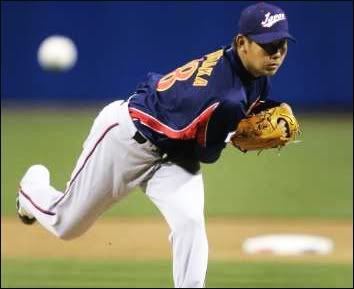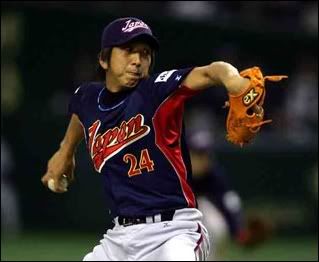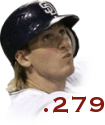
Over the last few seasons, Japanese pitchers have had quite a bit success in the majors. Relievers such as Shingo Takatsu have come over and had immediate success as a closer. Starters such as Hideo Nomo and Kazuhisa Ishii had initial success. However the crash and burn everyone points to his Hideki Irabu. Irabu and Ishii had varying success in Japan and initially enjoyed some in the major leagues, however eventually each of them were busts. The main reason could be embedded in the Japanese stat lines. Both guys were near the bottom of the league consistently when it came to walks. They had good stuff, although their fastballs dropped in the US - but the walk environment in Japan is a lot different than the US. In Japan the average walk rate is about 2.7 per 9 innings, but in the US it's over 3. So we would expect them to be hurt a lot by the change, moreso than the average Japanese starter. It's similar to home runs, where both guys had high homer rates for Japan, and the US is a lot more homer friendly.
However, Daisuke Matsuzaka's different. He does not have too many problems with the long ball, 13 this year in 186.3 innings. He also has well-above average command for the league. All of these things would allow us to believe that he would have a better translation to the american game. The translations I did involved adjusting their walk and home run rates to an american environment, calculating their FIP in Japan and then converting that to a 4.50 ERA environment using pythagorean. I then divided it by .925 to get a league difficultly adjustment. I am completely aware that this may have double counted the difficulty adjustment and the results I got bear that out. Later on I wish to find exact relationships between strikeout, walk, and home run rates using actual data of players swithing leagues, then calculating their FIP in the US using the MLB fip constant for the season. This time, I did find a good list on who would be able to do the best:
3.52 Daisuke Matsuzaka
3.68 Hiroki Kuroda
3.73 Kazumi Saito
3.94 Rick Guttormson
4.29 Naoyuki Shimizu
4.38 Yuya Ando
4.38 Dicky Gonzalez
4.39 Jeremy Powell
4.44 Masanori Ishikawa
4.58 Nagisa Arakaki
4.59 Shinobu Fukuhara
4.61 Kei Igawa
4.63 Daisuke Miura
4.64 Kazuhisa Ishii
4.64 Tetsuya Utsumi
4.82 Masahiro Yamamoto
Among the pitchers with 100 innings pitched, this list is the top third. The top third in the EqA translations were all above average in the US. Here 4.50 would be average in the US, so it looks as if I may have double counted a bit. Dicky Gonzalez, Jeremy Powell and Ishii have all spent time in the majors. Ishii's career ERA in the USA was 4.44 and his last season 4.71, so I guess it's a fair translation for him. Gonzalez hasn't had a lot of time in the US, but in his longest stint in 2001 he had a 4.88 ERA. It's tough with him because he was 22 at the time. In his only stint as a starter, Jeremy Powell had a 4.73 ERA as a 23 year old. All of these lead to suggest in a general sense there's nothing wrong with these translations. In case you were wondering, the starter who struck out Bonds three times in 2002 and dominated the US in the WBC, Koji Uehara had a 5.64 translation. Uber Japanese phenom Yu Darvish had a 5.86 translation but it's good to remember he spent most of the season as a teenager. Finally, 2005 Sawamura Award winnner Toshiya Sugiuchi had a rough season and translated at well over 6.00 after having a statline last season that would have translated to a mid 3.00s ERA. I will do these for previous seasons and see the trends.
 Finally, I would like to talk about the one and only Kyuji Fujikawa. It might be time to wonder how good this guy is compared to the elite major league closers. His fastball runs in the in the mid 90s sitting at 92-93. He has quite possibly the best forkball in the history of the game and a plus slider. He's never been tried as a starter over a full season for the Hanshin Tigers, but he's unfair out of the bullpen. Last year as a setup man he pitched 92.1 innings, struck out 139 guys to just 20 walks. He allowed 57 hits. He had a 1.36 ERA and was dominant out of the pen that took the Tigers to the Japan Series. However this year he was moved into the closing role and made his 2005 line look like weak. He pitched 79.1 innings with 122 strike outs and 22 walks. He allowed six runs. Six. He allowed 46 hits. He nearly had a 3:1 K:H ration and a 2:1 strikeout to baserunner ratio. His translated ERA was a hair over 2.00, but given the translation of guys like Takashi Saito and Kazuhiro Sasaki, he may do better. Unfortunately he's not a free agent for at least three more years.
Finally, I would like to talk about the one and only Kyuji Fujikawa. It might be time to wonder how good this guy is compared to the elite major league closers. His fastball runs in the in the mid 90s sitting at 92-93. He has quite possibly the best forkball in the history of the game and a plus slider. He's never been tried as a starter over a full season for the Hanshin Tigers, but he's unfair out of the bullpen. Last year as a setup man he pitched 92.1 innings, struck out 139 guys to just 20 walks. He allowed 57 hits. He had a 1.36 ERA and was dominant out of the pen that took the Tigers to the Japan Series. However this year he was moved into the closing role and made his 2005 line look like weak. He pitched 79.1 innings with 122 strike outs and 22 walks. He allowed six runs. Six. He allowed 46 hits. He nearly had a 3:1 K:H ration and a 2:1 strikeout to baserunner ratio. His translated ERA was a hair over 2.00, but given the translation of guys like Takashi Saito and Kazuhiro Sasaki, he may do better. Unfortunately he's not a free agent for at least three more years.
Of these, the three guys the Cubs are rumored to be interested in include Matsuzaka, Hiroki Kuroda and Kazumi Saito. Kuroda had a fabulous season as the ace of the Hiroshima Toyo Carp. He throws a good fastball in the l0w 90s with a good slider and decent pure offspeed stuff. In the US, he's probably a #3 type starter. Saito is more of a finesse guy with a sinking fastball. His translation is similar, probably a Jeff Suppan type pitcher. Another guy who the Cubs could be interested in is Kei Igawa. Igawa is a power lefty who has command issues but can get the strikeout. I am not so sure he'd adapt so well to the majors. He has great stuff, but he's got the same sorts of problems in Japan that plagued Ishii, Irabu and even Hideo Nomo. There really has not been a starter with good command to cross the ocean.
However, Daisuke Matsuzaka's different. He does not have too many problems with the long ball, 13 this year in 186.3 innings. He also has well-above average command for the league. All of these things would allow us to believe that he would have a better translation to the american game. The translations I did involved adjusting their walk and home run rates to an american environment, calculating their FIP in Japan and then converting that to a 4.50 ERA environment using pythagorean. I then divided it by .925 to get a league difficultly adjustment. I am completely aware that this may have double counted the difficulty adjustment and the results I got bear that out. Later on I wish to find exact relationships between strikeout, walk, and home run rates using actual data of players swithing leagues, then calculating their FIP in the US using the MLB fip constant for the season. This time, I did find a good list on who would be able to do the best:
3.52 Daisuke Matsuzaka
3.68 Hiroki Kuroda
3.73 Kazumi Saito
3.94 Rick Guttormson
4.29 Naoyuki Shimizu
4.38 Yuya Ando
4.38 Dicky Gonzalez
4.39 Jeremy Powell
4.44 Masanori Ishikawa
4.58 Nagisa Arakaki
4.59 Shinobu Fukuhara
4.61 Kei Igawa
4.63 Daisuke Miura
4.64 Kazuhisa Ishii
4.64 Tetsuya Utsumi
4.82 Masahiro Yamamoto
Among the pitchers with 100 innings pitched, this list is the top third. The top third in the EqA translations were all above average in the US. Here 4.50 would be average in the US, so it looks as if I may have double counted a bit. Dicky Gonzalez, Jeremy Powell and Ishii have all spent time in the majors. Ishii's career ERA in the USA was 4.44 and his last season 4.71, so I guess it's a fair translation for him. Gonzalez hasn't had a lot of time in the US, but in his longest stint in 2001 he had a 4.88 ERA. It's tough with him because he was 22 at the time. In his only stint as a starter, Jeremy Powell had a 4.73 ERA as a 23 year old. All of these lead to suggest in a general sense there's nothing wrong with these translations. In case you were wondering, the starter who struck out Bonds three times in 2002 and dominated the US in the WBC, Koji Uehara had a 5.64 translation. Uber Japanese phenom Yu Darvish had a 5.86 translation but it's good to remember he spent most of the season as a teenager. Finally, 2005 Sawamura Award winnner Toshiya Sugiuchi had a rough season and translated at well over 6.00 after having a statline last season that would have translated to a mid 3.00s ERA. I will do these for previous seasons and see the trends.
 Finally, I would like to talk about the one and only Kyuji Fujikawa. It might be time to wonder how good this guy is compared to the elite major league closers. His fastball runs in the in the mid 90s sitting at 92-93. He has quite possibly the best forkball in the history of the game and a plus slider. He's never been tried as a starter over a full season for the Hanshin Tigers, but he's unfair out of the bullpen. Last year as a setup man he pitched 92.1 innings, struck out 139 guys to just 20 walks. He allowed 57 hits. He had a 1.36 ERA and was dominant out of the pen that took the Tigers to the Japan Series. However this year he was moved into the closing role and made his 2005 line look like weak. He pitched 79.1 innings with 122 strike outs and 22 walks. He allowed six runs. Six. He allowed 46 hits. He nearly had a 3:1 K:H ration and a 2:1 strikeout to baserunner ratio. His translated ERA was a hair over 2.00, but given the translation of guys like Takashi Saito and Kazuhiro Sasaki, he may do better. Unfortunately he's not a free agent for at least three more years.
Finally, I would like to talk about the one and only Kyuji Fujikawa. It might be time to wonder how good this guy is compared to the elite major league closers. His fastball runs in the in the mid 90s sitting at 92-93. He has quite possibly the best forkball in the history of the game and a plus slider. He's never been tried as a starter over a full season for the Hanshin Tigers, but he's unfair out of the bullpen. Last year as a setup man he pitched 92.1 innings, struck out 139 guys to just 20 walks. He allowed 57 hits. He had a 1.36 ERA and was dominant out of the pen that took the Tigers to the Japan Series. However this year he was moved into the closing role and made his 2005 line look like weak. He pitched 79.1 innings with 122 strike outs and 22 walks. He allowed six runs. Six. He allowed 46 hits. He nearly had a 3:1 K:H ration and a 2:1 strikeout to baserunner ratio. His translated ERA was a hair over 2.00, but given the translation of guys like Takashi Saito and Kazuhiro Sasaki, he may do better. Unfortunately he's not a free agent for at least three more years.Of these, the three guys the Cubs are rumored to be interested in include Matsuzaka, Hiroki Kuroda and Kazumi Saito. Kuroda had a fabulous season as the ace of the Hiroshima Toyo Carp. He throws a good fastball in the l0w 90s with a good slider and decent pure offspeed stuff. In the US, he's probably a #3 type starter. Saito is more of a finesse guy with a sinking fastball. His translation is similar, probably a Jeff Suppan type pitcher. Another guy who the Cubs could be interested in is Kei Igawa. Igawa is a power lefty who has command issues but can get the strikeout. I am not so sure he'd adapt so well to the majors. He has great stuff, but he's got the same sorts of problems in Japan that plagued Ishii, Irabu and even Hideo Nomo. There really has not been a starter with good command to cross the ocean.


No comments:
Post a Comment